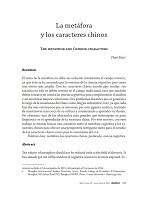The Metaphor and Chinese Characters
DOI:
https://doi.org/10.32870/mycp.v6i16.539Keywords:
Metaphor, Chinese Characters, Predicate, Cognitive ScienceAbstract
The subject of metaphor should not be reduced only to the field of rhetoric. It has already got out of the window of cognitive science to be more exposed. Something similar happens with Chinese characters: their study should not only focus on the traditional field, but also have to worry about cognitive theories to fill the blank, and perhaps to find better solutions to the teaching puzzles that have been generated along the teaching of CFL (Chinese as a foreign language). Because every day there are more foreigners who are interested in this Asian giant, trying to stay closer to his culture and beginning to learn their language. However, one of the biggest obstacles that intercept the linguistic step is the learning of Chinese writing. From this, our work here, trying to find a connection between the cognitive metaphor and Chinese characters in order to offer an intriguing perspective both for the Chinese characters’ study and the teaching of CFL.Downloads
References
Aristóteles. (1994). Retórica. (Traducción de Quintín Racionero.) Madrid, España: Gredos.
Benveniste, E. (1997). Problemas de lingüística general. México, DF: Siglo XXI Editores.
Black, M. (1966). Modelos y metáforas. Madrid, España: Tecnos.
Ding, E. (2012). 符号与意义 [Signos y significados]. 南京大学出版社 [Nanjing: Editorial de la Universidad de Nanjing].
Editorial Vox. (2009). “Metáfora”, Diccionario Vox de la Lengua Española. Barcelona, España: Vox.
He, D. (2003). 图画文字说与人类文字的起源 [Teoría de dibujo-caracteres y el origen de la escritura humana]. 中国社会科学出版社 [China: Editorial de la Ciencia Social].
Lakoff, G., y Johnson, M. (1999). Philosophy in the flesh: The Embodied Mind & its Challenge to Western Thought. Nueva York, Estados Unidos: Basic Books.
Lakoff, G., y Johnson, M. (2001). Metáforas de la vida cotidiana. Madrid, España: Cátedra.
Lamb, S. M. (1998). Pathways of the brain. Houston, Estados Unidos: Rice University.
Li, W., y Yang, H. (2001). 图说文字起源 [El origen de los caracteres con ilustraciones]. 重庆出版社 [Chongqing: Editorial de Chongqing].
Real Academia Española. (s/f). “Metáfora”, Diccionario de la Lengua Española en línea (Edición del Tricentenario). Recuperado de: http://dle.rae.es/?id=P4sce2c
Richards, I. A., y Lewis, C. S. (1936). The Philosophy of Rhetoric. Nueva York/Londres: Oxford University Press.
Saussure, F. (1945). Curso de lingüística general. Buenos Aires, Argentina: Losada.
Su, D. (2000a). 隐喻学研究 [Estudio de la metáfora]. 上海外语教育出版社[Shanghái: Editorial de la Educación de Lenguas Extranjeras].
Su, D. (2000b). “On the cognitive, psychological and linguistic causes for the emergence of metaphor”, Foreign Language Research, 100(2): 23-33.
Wang, X. (2010). 汉字起源图解 [El origen de los caracteres chinos con ilustraciones]. 北京大学出版社 [Beijing: Editorial de la Universidad de Beijing].
Zhou, Y. (2014). “The Structures of Ideographic Chinese Characters and Image Schema Thoughts”, Revista de la Universidad de Nanhua, 15(3): 94-97.

Downloads
How to Cite
Issue
Section
License
Open Access Policy
This journal provides open access to all its contents, in adherence to the principle that making research freely available supports a greater global exchange of knowledge.
MyCP is licensed under a Creative Commons Attribution-NonCommercial license, also known as CC BY-NC.
Contents are published in both PDF and XML formats.
Authors who publish in México y la Cuenca del Pacífico must accept the following conditions:
Pursuant to Mexican copyright laws, México y la Cuenca del Pacífico acknowledges and respects the authors’ moral right and ownership of property rights, which will be assigned to the University of Guadalajara to publish the articles in an open-access mode.
México y la Cuenca del Pacífico does not charge the authors any fees for receiving and processing their articles.
Authors are permitted to enter into other independent and additional contractual agreements for the non-exclusive distribution of the article version published in México y la Cuenca del Pacífico (for example, publishing it in an institutional repository or in other printed or electronic media) as long as they clearly state that the piece was originally published in México y la Cuenca del Pacífico.
Pursuant to the above, once the article is approved for publication, authors must send the Assignment of Rights Agreement form duly filled and signed. This form must be sent to mexicoylacuenca@gmail.com as a PDF file.
Readers/users of México y la Cuenca del Pacífico can freely access the journal new issues as soon as they are uploaded. Readers/users are allowed to cite, share (both electronically and physically), print and distribute the material, provided they expressly state that the work was originally published in México y la Cuenca del Pacífico. Contents are to be properly cited and never for commercial purposes.




